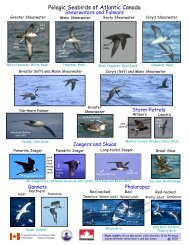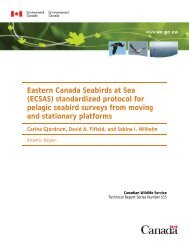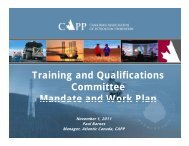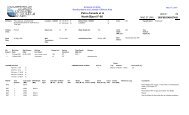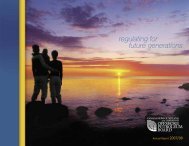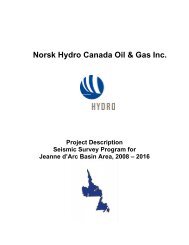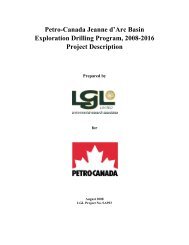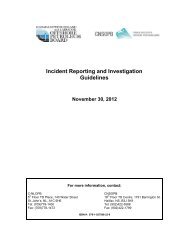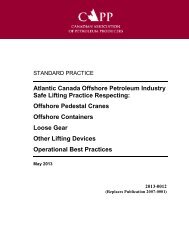Offshore Waste Treatment Guidelines - Canada-Nova Scotia ...
Offshore Waste Treatment Guidelines - Canada-Nova Scotia ...
Offshore Waste Treatment Guidelines - Canada-Nova Scotia ...
Create successful ePaper yourself
Turn your PDF publications into a flip-book with our unique Google optimized e-Paper software.
<strong>Offshore</strong> <strong>Waste</strong> <strong>Treatment</strong> <strong>Guidelines</strong>enhanced mineral oil based mud (EMOBM) in the drilling of wells and wellsections. Other than residual base fluid retained on cuttings as described in theoperator’s EPP (see Section 2.4 of these guidelines), no whole SBM or EMOBMbase fluid, or any whole mud containing these constituents as a base fluid,should be discharged to the sea.From an environmental perspective, oil based mud (OBM) is the least desirablebase fluid, although it may possess technical advantages in relation toparticularly technically challenging well sections. The use of OBM will beapproved only in exceptional circumstances. Under no circumstances should oilbase fluid or whole mud containing oil base fluid be discharged to the sea.2.4 Drilling SolidsDrilling solids or cuttings are particles that are generated by drilling intosubsurface geological formations and are carried to the surface with drillingmuds.Drilling solids associated with the use of WBM may be discharged to the marineenvironment without treatment.Each operator that plans to use SBM or EMOBM in development drilling should,as part of its development application, examine and report upon the technicalfeasibility and economic reasonability of re-injecting the associated drilling solidsinto subsurface formations at its drill site(s). For a drilling program where anoperator has demonstrated that re-injection of drilling solids associated with theuse of SBM or EMOBM is not technically feasible or economically reasonable,the operator’s EPP should describe the manner in which drilling solids will bemanaged and discharged to the marine environment. The operator shouldmanage drilling solids in a manner which achieves the lowest concentration ofdrilling fluid retained on cuttings using proven and practicable best practices. Thismay include technological approaches to cuttings treatment on the installation,strategies for mud management at the installation, and transfer of materials toonshore facilities for further treatment.At the time of writing of these guidelines, proven and practicable best availabletechnologies and practices in waste management and treatment are believed tobe capable of achieving a concentration of 6.9 g/100 g or less oil on wet solids.The performance target for “synthetic-on-cuttings” or “enhanced mineraloil-on-cuttings” concentration is as follows:the 48-hour mass weighted average of retained “synthetic-on-cuttings”or “enhanced mineral oil-on-cuttings” discharged to sea should notexceed 6.9 g/100 g oil on wet solids.15 December 2010 11



